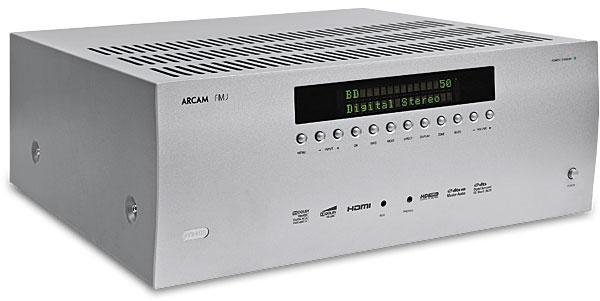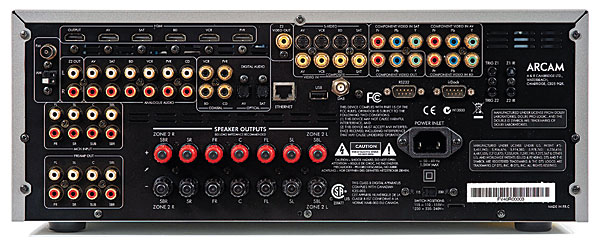Arcam AVR400 A/V Receiver

 Price: $2,499 At A Glance: Rated 90 watts x7 with all channels driven • Dolby Volume reconciles dialogue and effects • First 3D-compatible Arcam A/V receiver
Price: $2,499 At A Glance: Rated 90 watts x7 with all channels driven • Dolby Volume reconciles dialogue and effects • First 3D-compatible Arcam A/V receiver
Daddy, Am I High End?
What exactly is a high-end A/V receiver? Is it the most expensive and feature-rich model in a manufacturer’s line? Is it a model with power specs above a certain level? Is it a model that sells above a certain price point? Is it any model from a manufacturer with a high-end pedigree? There are some who insist the phrase “high-end A/V receiver” is a contradiction in terms. Before we split any more hairs, let’s all favor that kind of person with a dirty look. Under certain circumstances, it might be OK to throw a martini in his smug little face.
Now let’s run the Arcam AVR400 through those four filters. Is it the most expensive and feature-rich model in Arcam’s line? No, it’s the bottom model of three. Does it have power specs above a certain level? By Arcam’s standards, the AVR400 is the Baby Bear of the family, with 90 watts into 8 ohms times seven channels driven, versus 100 watts for the AVR500 and 120 watts for the AVR600. Does this new Arcam AVR sell above a certain price point? Well, if $1,000 and $2,000 are psychologically significant price points—and I think they are—then the answer is a double yes, although the AVR400 ($2,499) is less costly than the AVR500 ($3,499) and AVR600 ($4,999). Finally, does this AVR come from a high-end manufacturer? The short answer is yes. In general, Arcam products are on the affordable side of high-end, a constructive thing to be.
With two nos and two yeses, we may conclude that the AVR400 is a certain kind of high-end A/V receiver. It’s the kind that demands a significant investment, but the name on the front panel suggests that the product may be worth it.
Curving Green Landscape
Most A/V receivers have a utilitarian look, although Arcam carries it to an extreme. The most prominent elements on the AVR400’s front panel are the display, the row of buttons below the display, and the row of logos below the buttons. Each of these three elements is a symmetrically rigorous 8 inches wide on a front panel 17 inches wide. There are no knobs, not even for volume. If you want to change the volume from the front panel, your fingers have to seek out the two buttons at far right. But Arcam does make two concessions to the universal human need for beauty. One is made visible when you turn on the AVR and see the rich green of its display. The other is the faceplate’s subtle convex curve.
The remote control echoes the faceplate’s silver-grayness and convexity. Although the remote is backlit in blue, which can be helpful in the dark, it is otherwise one of my all-time least favorite remotes, with volume keys that are hard to find and not distinguished by size, shape, or color. Your custom installer may offer a better solution, but a product at this price should come with a decent remote.
The graphic user interface—in subtle black, white, and violet—is plain but pleasant looking. It’s especially well arranged for tweakers; Speaker Types, Speaker Distances, and Speaker Levels are all accorded the status of toplevel menu items. There’s a fifth definition of high-end AVR: the kind that makes life easier for the knowledgeable tweaker.
This A/V receiver’s back panel looks notably different than those of its higher-priced siblings. The other two Arcam AVRs arrange their jacks in columns, which made my plugging-in ritual easier. This one has a more conventional cluster layout. The difference reflects a change in design from the modular approach of the previous AVRs. In the two older models, all of the circuit boards plug into a motherboard, as in a PC. The new model saves money by using a non-modular design. Not a deal breaker, just an observation.

Returning to the subject of power: The AVR400’s 90 watts fall below another psychologically significant threshold, the all but meaningless 100-watt-perchannel spec. What you need to know is that Arcam rates its 90 watts conservatively, with all channels driven. Squint closely at spec sheets, and you’ll see how other manufacturers weasel out—by specifying power into just one or two channels driven. Try driving all channels on those models simultaneously, and you’ll often see the power output clamp down—sometimes precipitously. This may or may not be truly meaningful, as no real-world program content would ever tax an amplifier this way. But you’ll find the ability to continuously drive all channels at once an indicator of a robust power supply, and only the most honestly rated amps and AVRs will make this spec. As always, see our measurements for the final verdict.
I should note in passing that neither the AVR400 nor the step-up AVR500 use the railswitching amp architecture of the AVR600, which gives the top model tremendous reserves of power. In practice, the AVR400 did a beautiful job of running my Paradigm Reference Studio 20 v.4 speakers.
Arcam doesn’t load up its A/V receivers with extraneous features, but the AVR400 does have a few significant pluses. One is Dolby Volume, which I comment on in some detail in my review of the Anthem MRX 300 elsewhere in this issue. It evens out volume levels among source components and within programs and lets you narrow a program’s dynamic range in multiple steps—helpful when you’re trying to keep dialogue high enough to be audible and loud effects low enough to be bearable. And it helps maintain the same perceived frequency response at any listening level.
Network audio functions are becoming common now in A/V receivers. This one includes vTuner Internet radio functionality via the AVR’s Ethernet port. Once you make that connection to your home network, you can also pull music out of a router-connected PC. And a back-panel USB jack allows access to music files from a stick or external hard drive.
For your iPod fix, connect the irDock ($285). In a world where iPod docks rarely top $150, why is this one so costly? Arcam explains: “It’s a great-sounding analog dock with carefully regulated power supplies, switchable iPod charging, superior resonance control, and S- and composite video outputs. The serial connection allows full remote control when used with Arcam’s AVRs, as well as a separate IR remote control for non-serial-control applications.”
On the video side, the AVR400 is noteworthy for being Arcam’s first 3D-capable A/V receiver. Whereas previous models were outfitted with only HDMI 1.3, the new one is 1.4a compliant, with support for ARC and CEC. The Pixelworks video processor that Arcam used in its previous two AVRs has given way here to a Genesis Torino. It might be instructive to compare the Video Test Bench section of this review to those of the AVR600 and AVR500 reviews (HT, August 2009 and August 2010).
While this A/V receiver does include homegrown auto setup and room correction, the manufacturer urges consumers to solve acoustic problems the oldfashioned way—with correct speaker positioning and perhaps wall treatment—resorting to room correction as “your next best choice.” I ran the auto setup and let the speaker distance settings stand, although I did change the speaker size from large to small and raised the crossover to 80 hertz (my usual settings). Since my room sounds decent without room EQ, barring a little bass bloat, I elected to keep the room correction off, allowing direct contemplation of the AVR’s amp quality and other essential characteristics.
- Log in or register to post comments




































































